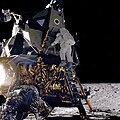月球坑观测和传感卫星
 LCROSS和半人马座火箭航行艺术想象图 | |
| 所属组织 | NASA/艾密斯研究中心 |
|---|---|
| 任务类型 | 撞击式 |
| 发射时间 | 2009-06-18 21:32:00 UTC |
| 发射手段 | 宇宙神5号 401 |
| 发射地点 | 卡纳维拉尔角空军基地 41号航天发射复合体 |
| 任务时长 | 2009年6月18日 – 2009年10月9日 航行时间: 15年5個月27日 |
| COSPAR ID | 2009-031B |
| SATCAT no. | 35316 |
| 官方网站 | http://www.nasa.gov/LCROSS |
| 质量 | LCROSS Shepherding Spacecraft: 621 kg (1,369 lb) (min.); Centaur at impact: 2,249 kg (4,958 lb) (min.)[1] |
| 轨道参数 | |
| 参考坐标系 | 地心 |
| 轨道类型 | 高地球軌道 |
| 周期 | 37 天 |
月球觀測和傳感衛星(Lunar Crater Observation and Sensing Satellite,簡稱LCROSS)是2009年6月18日美國國家航空暨太空總署(NASA)發射的一顆月球探測衛星。該任務被認為是確定在月球極地地區檢測到的氫的性質的一種低成本手段。[2] 在月船1号 (Chandrayaan-1) 發現月球水後立即發射,[3] LCROSS 的主要任務目標是進一步探討月球極地地區附近永久陰影隕石坑中是否有冰形式的水。[4] 成功確認月球南部卡比厄斯环形山有水。[5]
它於2009年6月18日與月球勘测轨道飞行器 (LRO) 一起發射,作為共享月球先锋机器人计划(Lunar Precursor Robotic Program)的一部分,這是十多年來美國首次登月任務。
LCROSS 的設計目的是收集和轉發運載火箭的廢半人馬座火箭上級(以及數據收集的牧羊號飛船)撞擊月球南極附近的卡比厄斯环形山隕石坑所產生的撞擊和碎片羽流的數據。
半人马座火箭的標稱衝擊質量為2,305 公斤(5,081 磅),衝擊速度約為9,000 km/h(5,600 mph),[6][7] 釋放的爆炸当量動能相當於引爆約2 千噸TNT(7.2 TJ ) 。
LCROSS 於 8 月 22 日發生故障,耗盡了一半的燃料,太空船中只剩下很少的燃料餘裕。[8]
半人马座火箭於世界標準時間2009年10月9日 11:31 成功撞擊。 在撞擊六分鐘後於世界標準時間 11:37 ,牧羊號飛船下降穿過半人馬座的噴射羽流,收集並轉發數據。[9]
與當時的媒體報導相反,從地球上用肉眼或望遠鏡都看不到這次撞擊及其塵埃雲。
結果
[编辑]視覺上的影響並不像預期的那麼明顯。 專案經理丹·安德魯斯(Dan Andrews)認為,這是由於碰撞前的模擬誇大了羽流的突出程度。 這導致需要進行影像處理以提高清晰度。 紅外線攝影機也捕捉了助推器撞擊的熱訊號。[10]
水的存在
[编辑]2009年11月13日,NASA宣佈,月球觀測和傳感衛星在2009年10月9日撞擊月球的過程中,產生部份塵埃,科學家經過分析獲得數據顯示出水確切的存在於月球上。
2018年8月20日,美國太空總署確認月球兩極表面有冰。[11]
影像
[编辑]-
One of the first images from the Lunar Crater Observation and Sensing Satellite (LCROSS) using the visible light camera during the swingby of the Moon. LCROSS has nine science instruments that collect different types of data which are complementary to each other.
-
An infrared camera image of the Moon taken with the Lunar Crater Observation and Sensing Satellite (LCROSS) mid-infrared camera. This is the first infrared image ever taken of the far side of the Moon.
-
Another visible light camera image of the Moon taken by the LCROSS spacecraft during lunar swingby
-
Near infrared image of the LCROSS Centaur separation as seen from the LCROSS Shepherding Spacecraft
-
Mid infrared (false color) image of the LCROSS Centaur separation (red->hot, blue->cold)
-
STK (Satellite Tool Kit) image of the LCROSS spacecraft after Centaur separation
-
Image taken of the Centaur upper stage impact in the Cabeus crater near the south pole of the Moon. The images were taken by the LCROSS Shepherding Spacecraft.
-
Locations of the Diviner LCROSS impact swaths overlain on a grayscale daytime thermal map of the Moon’s south polar region. Diviner data were used to help select the final LCROSS impact site inside Cabeus Crater, which sampled an extremely cold region in permanent shadow that can serve as an effective cold trap for water ice and other frozen volatiles.
-
Preliminary, uncalibrated LRO/Diviner thermal maps of the Centaur/LCROSS impact site acquired two hours before the impact, and 90 seconds after the impact. The thermal signature of the impact was clearly detected in all four Diviner thermal mapping channels.
参看
[编辑]注释
[编辑]- ^ LRO/LCROSS Press Kit v2 (PDF). NASA. [2009-08-04]. (原始内容存档 (PDF)于2009-10-27).
- ^ Tompkins, Paul D.; Hunt, Rusty; D'Ortenzio, Matt D.; Strong, James; Galal, Ken; Bresina, John L.; Foreman, Darin; Barber, Robert; Shirley, Mark; Munger, James; Drucker, Eric. Flight Operations for the LCROSS Lunar Impactor Mission (PDF). NASA (Ames Research Center). April 25, 2010 [September 27, 2011]. (原始内容存档 (PDF)于2024-02-23).
- ^ Indian lunar mission finds water on moon. TheGuardian.com. September 24, 2009.
- ^ NASA - LCROSS: Mission Overview. Nasa.gov. [November 14, 2009]. (原始内容存档于May 5, 2010).
- ^ Dino, Jonas; Lunar CRater Observation and Sensing Satellite Team. LCROSS Impact Data Indicates Water on Moon. NASA. November 13, 2009 [November 14, 2009]. (原始内容存档于January 6, 2010).
- ^ 引用错误:没有为名为
Moonstar的参考文献提供内容 - ^ NASA's LCROSS Mission Changes Impact Crater. NASA. September 29, 2009 [November 21, 2009]. (原始内容存档于October 28, 2009).
- ^ Stephen Clark. Managers mull options after moon mission malfunction. Spaceflight Now. August 25, 2009 [2024-05-11]. (原始内容存档于2024-08-05).
- ^ TheStar.com (页面存档备份,存于互联网档案馆), "NASA crashes rocket into moon".
- ^ Musser, George. LCROSS strikes Earth's moon as other moons continue to puzzle: Fourth dispatch from the annual planets meeting. Scientific American. October 9, 2009 [2024-05-11]. (原始内容存档于2011-03-19).
Shortly before the spacecraft itself hit, word came through that the infrared camera had indeed seen a thermal signature of the booster's crater.
- ^ Ice Confirmed at the Moon's Poles. NASA/JPL. [August 21, 2018]. (原始内容存档于2021-01-03).
- ^ Visible light camera image during lunar swingby. NASA. June 23, 2009 [August 10, 2009]. (原始内容存档于2022-01-29).
- ^ LCROSS Centaur Separation. NASA. October 9, 2009 [October 13, 2009]. (原始内容存档于October 11, 2009).
- ^ Visible light camera image during lunar swingby. NASA. October 9, 2009 [October 13, 2009]. (原始内容存档于2023-06-01).












